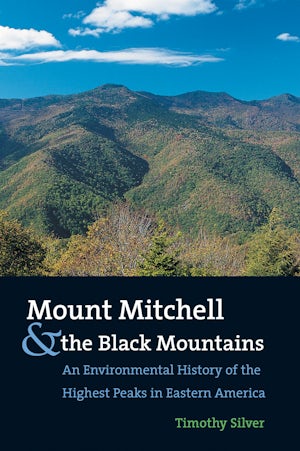Mount Mitchell and the Black Mountains
An Environmental History of the Highest Peaks in Eastern America
By Timothy Silver
352 pp., 6 x 9, 46 illus., 5 maps, notes, index
-
Paperback ISBN: 978-0-8078-5423-5
Published: March 2003 -
E-book EPUB ISBN: 978-0-8078-6314-5
Published: December 2003 -
E-book PDF ISBN: 979-8-8908-6813-8
Published: December 2003
Buy this Book
- Paperback $34.00
- E-Book $19.99
Awards & distinctions
2004 Phillip D. Reed Memorial Award, Southern Environmental Law Center
2003 Old North State Award, North Carolina Literary and Historical Association
Among the many tales Silver recounts is that of Elisha Mitchell, the renowned geologist and University of North Carolina professor for whom Mount Mitchell is named, who fell to his death there in 1857. But nature's stories--of forest fires, chestnut blight, competition among plants and animals, insect invasions, and, most recently, airborne toxins and acid rain--are also part of Silver's narrative, making it the first history of the Appalachians in which the natural world gets equal time with human history. It is only by understanding the dynamic between these two forces, Silver says, that we can begin to protect the Black Mountains for future generations.
About the Author
Timothy Silver is professor of history at Appalachian State University in Boone, North Carolina. His previous publications include A New Face on the Countryside: Indians, Colonists, and Slaves in South Atlantic Forests, 1500-1800.
For more information about Timothy Silver, visit
the
Author
Page.
Reviews
"[An] instructive story of both ecological change and the impact of human activity on the natural environment. . . . [Silver's] interweaving of his personal journal of visits to the mountains adds a surprisingly spiritual dimension to the scholarly narrative. This book is politically, culturally, philosophically, biologically, and--for its author and its readers--personally engaging."--Mountain Research and Development
"An excellent case-study in environmental history. The emphasis on the role of human decisions in the composition and workings of contemporary ecosystems coupled with the recognition that 'nature' is also an active player makes the book worthwhile reading for geographers as well as ecologists, for students and educators as well as the general public."--Historical Geography
"Silver acts as both nature guide and interpreter of history in his book. . . . As a naturalist he is skilled, thoughtful, and engaging. . . . This is matched by equal competency as a historian, including the ability to labor productively in multiple fields."--Journal of American History
"Like the natural world that is his subject, Timothy Silver's new environmental history of Mount Mitchell and the Black Mountains is complex and compelling. . . . Gracefully written and well-organized. . . . Silver's work is one of only a handful of studies that consider the natural world as an active agent in the Appalachian history and, as such, is an important contribution to the field."--H-Appalachia
"The environmental history of the Appalachian Mountain region is a field that recently has seen the publication of several very good books, of which Timothy Silver's Mount Mitchell and the Black Mountains is one. . . . A very worthwhile book."--H-Environment
"[A] passionate . . . [and] accessible work that will satisfy both the professional historian and the inquisitive citizen."--American Historical Review




